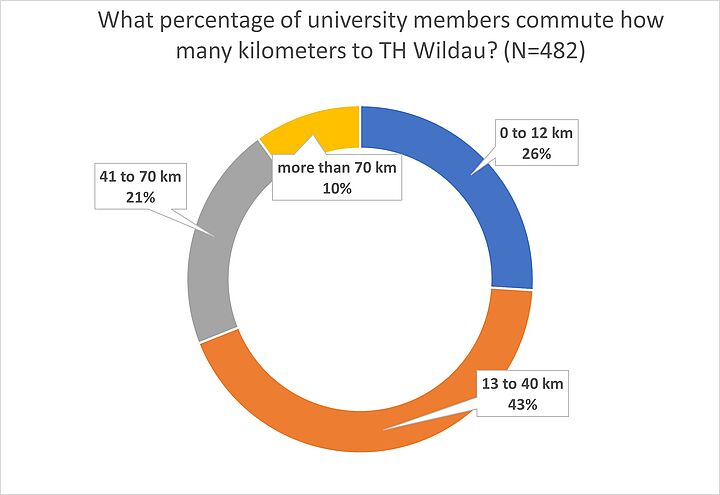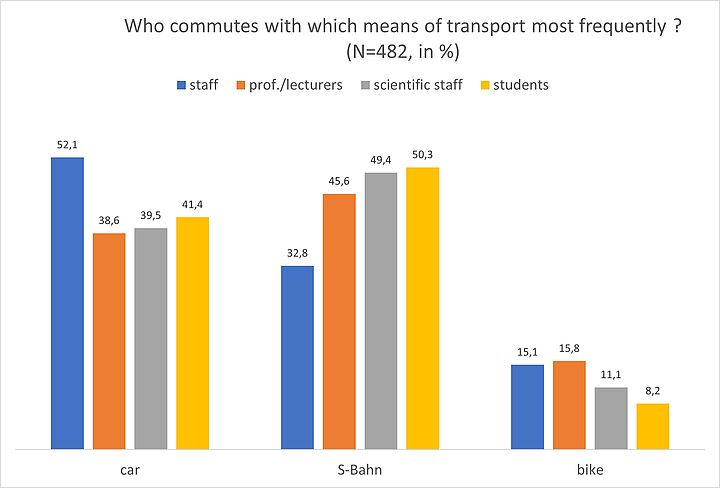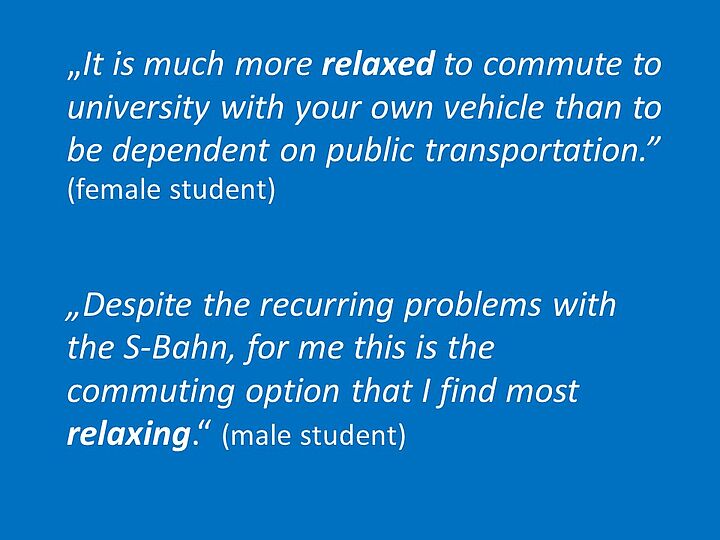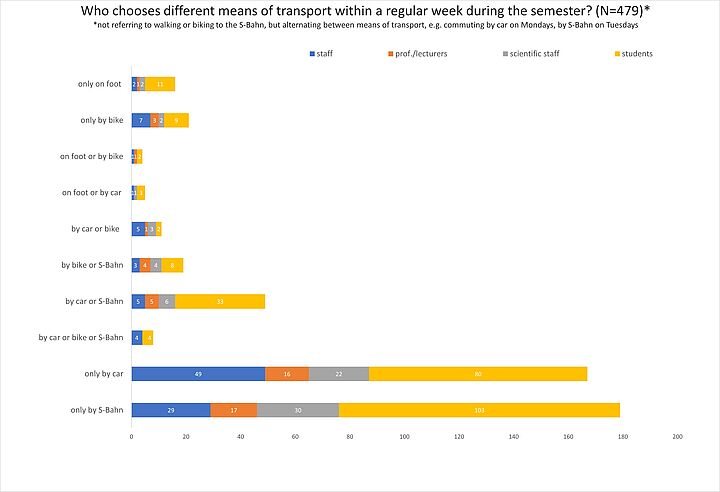Survey on the mobility behavior of university members
At the end of the summer semester 2024, we asked university members “How do you commute to TH Wildau?” This is already the second survey on this topic. The first survey on commuting behavior took place in spring 2023. With these mobility surveys, we want to learn about the diversity of university members' mobility decisions, document them, and identify the potential for change.
Why do we need data on commuting behavior?
Information on the commuting behavior of university members supports the further development of the mobility management of the TH Wildau. The accessibility of our university contributes to its attractiveness. Among other things, the modalities of daily travel to and from work can influence health and well-being. If we know and understand the mobility behavior of students, staff and teachers, we can also develop measures to reduce greenhouse gas emissions together with all stakeholders and actors from the region, thus contributing to the Brandenburg climate plan (Klimaplan Brandenburg).
How far do we commute to TH Wildau?
Data analysis shows that the majority of university members have a long commute to the TH Wildau. Four brackets of distance measures emerged when bundling the reported distances by frequency of being mentioned. As can be seen in the graphic, a little more than a quarter of university members live within a radius of about 12 km around TH Wildau, 43 % come from distances between 13 and 40 km, another 21 % live up to 70 km away from the Technical University of Applied Sciences Wildau and a group of 10 % of university members have travel distances of more than 70 km. Commuters who travel long distances include students, non-scientific staff, professors, lecturers and scientific staff.
How often do we commute to TH Wildau?
The distance travelled between home and university barely correlates with the number of days of attendance during the semester. The availability of home office regulations and online classes is welcomed by many university members, regardless of the distance between their place of residence and TH Wildau. The graphic on the question “Who is on campus during the semester and how often?” shows that university members on average are most frequently present on campus on four days a week. This includes commuters who travel over 70 km.
What means of transportation do we use to commute to TH Wildau?
University members travel to TH Wildau by public transport, by car and by bicycle. An important finding is that for some survey participants there is no alternative to the means of transport available for their commute. However, another group of survey participants has access to all three means of transport and is able to switch between them. This is also shown in the last graphic below.
The S-Bahn station Wildau, which is located close to the university, is an opportunity for many university members to travel by public transport as often as possible. If there is no public transportation (e.g. bus, call-a-bus, tram, subway, regional trains, etc.) at the place of residence that can take commuters to the university or connect them to the S-Bahn line, or if the frequency of the trips is so far apart that a time-effective journey to the university is not possible, then – depending on the length of the route – a bicycle or a car is used. Only a few survey participants can walk from their home to their place of study or work. The next graphic shows who uses which type of transportation most frequently.
What are the reasons for choosing a particular means of transportation?
The duration of the commute varies for car drivers between 5 and 180 minutes, with 20-30 minutes being the most frequently stated; public transport users travel between 10 and 120 minutes, with 60 minutes being the most frequently stated. Cyclists travel between 3 and 45 minutes, with most of them cycling 15 minutes to the Technical University of Applied Sciences Wildau.
The survey also asked about the reasons for the choice of transport. In addition, participants were able to reflect on their considerations in the free-text-fields. The wealth of feedback reveals several patterns. 20% of the participants describe that they have no alternative to their means of transport. Commuters who don’t own a car rely on the S-Bahn as their main option to arrive at TH Wildau. Other have no alternative to commuting by car because there is no public transportation offered near their residence and/or they are unable to use other means of transportation due to health reasons. Most often, participants cite financial reasons for their choice of transportation, followed by a third who describe their transportation as the best option for those wanting to contribute to environmental protection. Additional justifications for their choices were either a) it offers the greatest time saving or b) it is considered the most comfortable or pleasant means of transport or c) it is the most reliable means of transport.
It is interesting to note that attributes such as “relaxing”, “time-saving” and “reliable” are used by both suburban train passengers (S-Bahn riders) and car drivers. The comparison of sentences on the slide to the left is one of many examples of similar statements about different means of transport. For one person, relaxing on the S-Bahn, not being stuck in traffic, while being able to prepare assignments for class means saving time. For the other, driving is the more time-efficient option and relaxing because there is no waiting time on the platform and no train cancellations that may disrupt the schedule.
Where are opportunities for change?
The analysis of the data shows, among other things, that there is a group of university members who can choose between different means of transport and occasionally do so. Some travel by car on some days and by public transport on other day of the week. Others switch between bicycle and car or even between bicycle, car and public transport. This is shown in the graphic on the question “Who switches between means of transport during a regular week in the semester?”
More climate-friendly mobility of university members is possible
We can deduct from this: the mobility of university members may become more climate-friendly.
Some university members wrote that they would use the S-Bahn more often for commuting if there were better connections between the S-Bahn and regional trains when changing in Königs Wusterhausen.
Another possibility is to encourage organizing carpools, for example with apps for carpool commuters. Currently, 18 % of drivers occasionally travel with other passengers in the vehicle.
In addition, survey participants who can reach the university by bicycle would like to see more and better developed bicycle paths that lead directly to the TH Wildau and bicycle safety boxes on campus to secure their bicycles. It is quite possible that this would encourage some commuters to switch to cycling more often. Further incentives for cyclists could be a consideration of the total annual costs of cars, which might matter when an old car needs to be replaced. The health benefits of cycling, which also apply to the use of pedelecs (e-bikes), can also be a reason to switch.
Structural change may have an influence on mobility decisions. The Deutschlandticket (Germany ticket) and the semester ticket were mentioned by several participants as reasons for their choice of means of transport, as in this written contribution: “Now that I have a semester ticket, I’m certainly using it.”




